Fecal Microbes In 60% of Sampled Wells
Tests show waste from Kewaunee County’s 97,000 cattle contaminates majority of wells.

Maureen Muldoon, a geology professor from the University of Wisconsin-Oshkosh, presented data on the source and method of water contamination in Kewaunee County during a meeting at the Expo Hall at the Kewaunee County Fairgrounds, June 7, 2017. They presented data showing that both human and bovine wastes contributes to the contamination. “I cannot think of a hydrogeologically worse place than northeast Wisconsin to put a lot of cows,” said Muldoon. Photo by Coburn Dukehart of the Wisconsin Center for Investigative Journalism.
Up to 60 percent of sampled wells in a Kewaunee County study contained fecal microbes, many of which are capable of making people and calves sick, two scientists told hundreds of local residents gathered at a public meeting Wednesday night.The microorganisms included Cryptosporidium, a parasite that comes from both people and animals. Researchers estimated Crypto in drinking water is likely infecting 140 of the county’s 20,000 residents each year.
More than 200 people gathered at the Expo Hall at the Kewaunee County Fairgrounds to hear the latest results of a study into the source of viruses, bacteria and parasites in their private well water, and what, if anything, they can do to protect their health. The crowd was quiet during the 90-minute session, with many taking photos and notes.
Kewaunee County, where cattle outnumber people nearly 5 to 1, has become a focal point in Wisconsin over whether local, state and federal governments adequately protect drinking water from manure from dairy farms, especially in areas of fractured bedrock, which is common in northeastern Wisconsin. The latest results show an even higher percentage of well contamination than earlier rounds of testing, which had found that about one-third of tested wells were polluted.
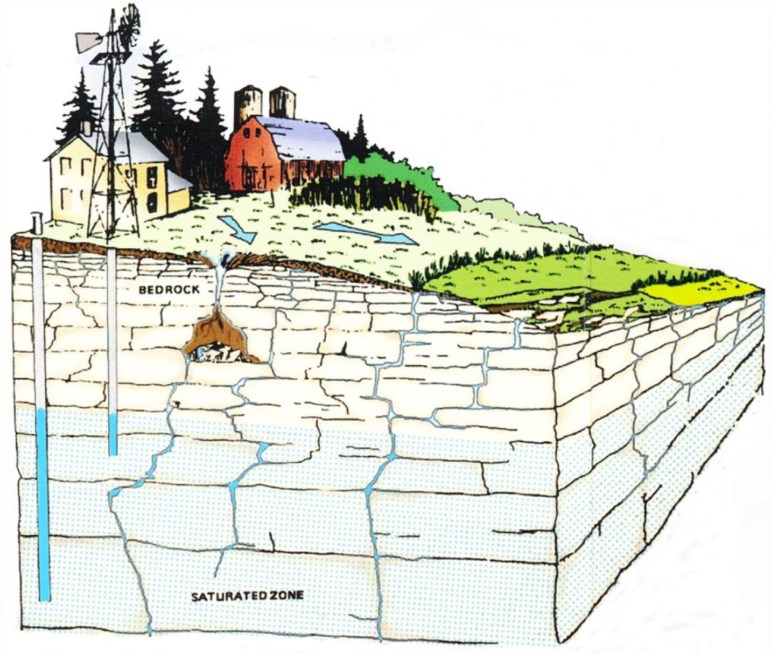
This is a diagram of land sitting atop fractured bedrock, also known as karst. The vertical fractures can carry water and contaminants from the surface to the groundwater. At left in the diagram are two wells drilled at varying depths into the aquifer. Diagram from the Door County Soil and Water Conservation Department.
According to the study, financed in part by the state Department of Natural Resources, the source of the contamination is both bovine and human waste that enters groundwater through cracks in so-called karst or fractured bedrock in Kewaunee County. The DNR began supplying bottled water this spring to local residents whose wells were found to be tainted by manure.
The researchers cautioned that the percentage of wells with microbial contamination may be even higher than their data show, since the 131 targeted wells were sampled only once during the study period, from April 2016 to March 2017.
“It’s my professional opinion, based on 25 years of experience, that if we sampled more than once, (the contamination rate) would creep up to 90 percent,” Mark Borchardt, a microbiologist with the U.S. Department of Agriculture’s Agricultural Research Service, told the crowd.
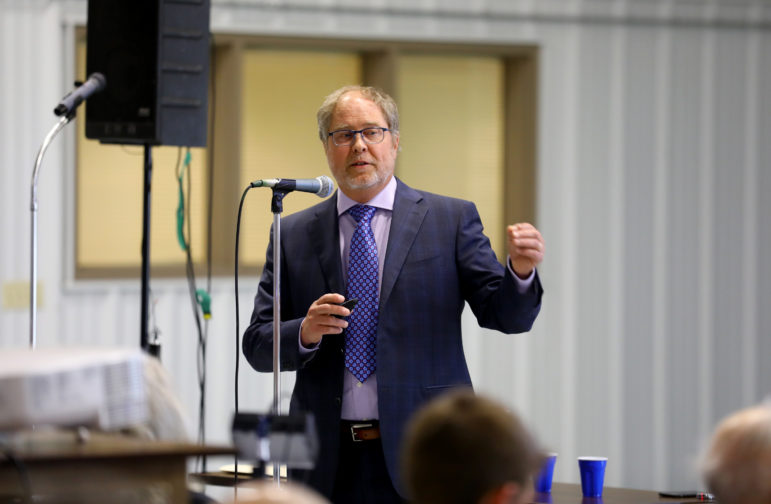
Mark Borchardt, a microbiologist with the U.S. Department of Agriculture’s Agricultural Research Service, presented data on water contamination in Kewaunee County during a meeting at the Expo Hall at the Kewaunee County Fairgrounds, June 7, 2017. Scientists found both bovine and human waste are to blame. Photo by Coburn Dukehart of the Wisconsin Center for Investigative Journalism.
According to Borchardt’s research, 40 of the 79 tainted wells contained bovine microbes; 29 contained human microbes, and seven had both. The remainder of the contaminated wells had microbes that could have come from either source.
About 20 written questions were submitted after the talk, many focused on how the scientists knew for sure that human waste was not being added to manure lagoons, possibly masking the true source of the human contamination. Borchardt said that even if that was happening, the amounts would have little effect on the results.
One participant asked whether dispensing less liquid manure would reduce well contamination. “You don’t need a scientist for that one,” Borchardt answered. “If you remove the fecal source, you remove the contamination.”
While the presentation was met with applause, some were left confused by the results.
“I’m having a hard time wrapping my head around it,” Kewaunee County resident Sandy Winnemueller said. “Obviously we shouldn’t have septic systems if they aren’t working. We haven’t solved a darn thing. This study has just muddied the waters.”

Gerald Pellett takes a photo during a meeting. “I’m really enthused about absorbing what was presented,” he said. “Just like all good studies it brings out more questions.” Photo by Coburn Dukehart of the Wisconsin Center for Investigative Journalism.
Nancy Utesch, a local beef farmer and member of advocacy group Kewaunee Cares, said she believes the picture is even worse than the data suggest.
“What people really suspect here is that it’s much worse than the last few years of research implicate,” she said. “It’s become an acceptable way of life here. People just know at certain times of the year not to drink the water.”
In an interview before the presentation, researcher Maureen Muldoon said that due to the fast movement of groundwater through the aquifer, water quality can change in a matter of hours. She affirmed that one sample does not adequately reflect well quality.
“Your well can be fine one day, then contaminated, then fine again,” said Muldoon, a geology professor at the University of Wisconsin-Oshkosh. “It’s like, if you wanted to measure the (annual) temperature and you only went out for one day.”
Wells selected for sampling
Kewaunee County has 4,896 private wells. The study tested water from 621 of them representing wells with various depths of soil to bedrock. Of those wells, 208 tested high for total coliform or nitrate. From that subset, 131 wells were randomly selected for further testing.
“We purposely chose wells that had indicators of water quality problems in order to determine the source (of contamination),” Muldoon said.

These maps show groundwater contamination susceptibility, left, and bedrock depth in east-central Wisconsin. Map from the University of Wisconsin-Extension / Center for Watershed Science and Education.
Seventy-nine of those wells were contaminated by a fecal microorganism — either a virus, parasite or bacteria — 62 of which were linked directly to either bovine or human sources. The other microbes could have come from either source, the researchers found.
The parasite Crypto was found in 12 percent of the sampled wells, with rotavirus A turning up in 14 percent. Borchardt noted that the concentration of bovine-specific rotavirus A was extremely high, in the thousands of “bugs per quart” compared to the concentration of human-specific ones. Other pathogens found included E. coli, Salmonella and rotavirus C, the last of which Borchardt said is rarely detected in groundwater.

Maureen Muldoon stressed the variability of well results due to rapid flow of water through the aquifer. “Your well can be fine one day, then contaminated, then fine again,” Muldoon said. Photo by Coburn Dukehart of the Wisconsin Center for Investigative Journalism.
The sampling found both Cryptosporidium hominis, which is human specific, and also Cryptosporidium parvum, which can transfer back and forth between people and cattle. According to the CDC, symptoms of Cryptosporidiosis can be serious, and can lead to severe or life-threatening illness for people with weakened immune systems.
A cryptosporidium outbreak in the Milwaukee area in 1993 was responsible for sickening more than 400,000 people and killing 69, after the parasite got into Lake Michigan water distributed by one of the city’s two treatment plants. According to the Milwaukee Journal Sentinel, it was the largest waterborne disease outbreak in U.S. history.
In Kewaunee County, the scientists estimated that 3.1 percent of private wells providing drinking water for both humans and calves are contaminated with Cryptosporidium parvum. Of the 12,200 people using private wells in the county, a projected 140 people per year are infected, as well as 1,700 calves.

About 200 people attended the meeting at the Expo Hall to learn about the source and method of contamination in Kewaunee County’s private well water. Photo by Coburn Dukehart of the Wisconsin Center for Investigative Journalism.
Borchardt said rotavirus C is one of the few gastrointestinal viruses that can go back and forth between humans and bovine. It can cause diarrhea, vomiting, dehydration and possible death.
“Rotavirus C is more widely understood to be found in India and China, but new studies are showing that it’s starting to appear in the U.S.,” Borchardt said in an interview. “We’ve never seen these results in groundwater before.”
“If I was a rotavirus C and I wanted to retire,” he added, “ I would move to Kewaunee County.”
Question of ‘environmental justice’
Borchardt said he considers the contamination in Kewaunee County to be a matter of “environmental justice” for those who cannot afford treatment systems such as reverse osmosis, which can cost up to $17,000 per home.

Mark Borchardt said calling homeowners to tell them they had pathogens in their well water “were some of the hardest professional days I had.” Photo by Coburn Dukehart of the Wisconsin Center for Investigative Journalism.
“Some people have the money to fix it, but there are many people who can’t even find $500 dollars to put in a treatment system at one faucet,” he said.
Borchardt said when dangerous pathogens were found in private wells during the course of the study, homeowners got phone calls right away to alert them to the results.
“That was really tough,” he said at the meeting. “Some of you I had to call and say ‘There’s Salmonella in your water.’ Those were some of the hardest professional days I had.”
Borchardt got emotional as he recalled those conversations. “I know I’m getting a little mushy, but I care a lot about this county and the people who participated in this study,” he said.
Soil depth little protection
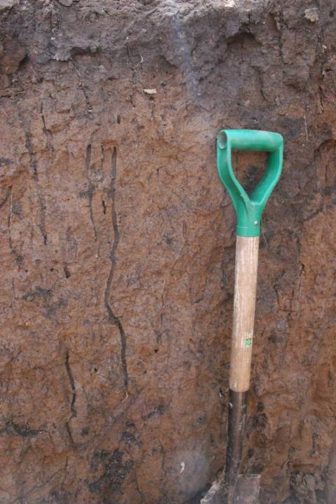
This image shows a 15-foot-deep pit in Dodge County where manure can be seen running down worm burrows. It demonstrates that manure can infiltrate to great depths through cracks and pathways in the soil, such as those found in Kewaunee County. Photo courtesy of Fred Madison of the Wisconsin Geological and Natural History Survey.
The researchers’ original hypothesis was that the greater the depth of the soil, the greater the protection from pollution. And while readings at shallow depths under 5 feet exceeded statewide averages for contamination by nitrate, total coliform and E. coli, they also found more contamination than expected in deeper layers, even where soil depths exceeded 20 feet.
“(Contamination) is worst where the soil is shallowest, because that’s where things get in. If you have 80 feet of clay, it will be diluted. If you are in the center of the county with shallow depth to bedrock, you are very vulnerable,” Muldoon said.
“I cannot think of a hydrogeologically worse place than northeast Wisconsin to put a lot of cows,” she added.
The study was done in conjunction with Randy Hunt from the U.S. Geological Survey’s Wisconsin Water Science Center. The presentation was organized by the Kewaunee County Land and Water Conservation Department.
At the end of the meeting, Davina Bonness, the head of the land and water conservation department who helped with the study, said, “This research has never been done in any county before. We have a lot of really great data, and I urge the County Board to really soak this in.”
DNR policy adviser Russ Rasmussen said the findings will help his agency develop policy, including proposed changes to administrative rules aimed at preventing manure runoff.
“The DNR wants to find out what’s going on to make good policy decisions,” he said after the meeting. “We are working on implementing all the recommendations that apply to us. We are taking this issue very seriously.”
Cattle outnumber people in Kewaunee
Concentrated Animal Feeding Operations, large farms with more than 1,000 animal units, are allowed to spread manure on land with only 2 feet to bedrock. Kewaunee County has 97,000 cows, heifers and calves, of which 45,500 are dairy cows, according to the U.S. Department of Agriculture. There are 15 dairy and one beef CAFO in the county, producing approximately 700 million gallons of manure per year.

A karst cliff face is exposed at the George K. Pinney Park in southern Door County. The fractured bedrock is common to Door and Kewaunee counties, allowing contaminants on the surface to move rapidly through the vertical fractures into the groundwater. Photo by Coburn Dukehart of the Wisconsin Center for Investigative Journalism.
In comparison, the county has about 20,000 people served by 4,822 septic systems. According to Borchardt, about 200 million gallons of septic effluent are released below ground per year, including human waste and water from showers, dishwashers and laundry machines. Septic systems leach into the subsurface by design, but “if it hits a crack, away it goes” into the groundwater, he said.
The fractured nature of the bedrock in Kewaunee County allows for water to easily infiltrate to the subsurface, especially after rain or or snowmelt. The researchers placed autosamplers in three homes to continuously test water quality during periods of recharge.
Using the autosamplers, they detected coliform numbers going from 10 parts per million to 1,000s of ppm within the span of 12 hours as the aquifer recharged, showing that a home’s water chemistry can change dramatically within a short period of time.
“It’s like sampling a river. It’s highly variable,” Borchardt said.
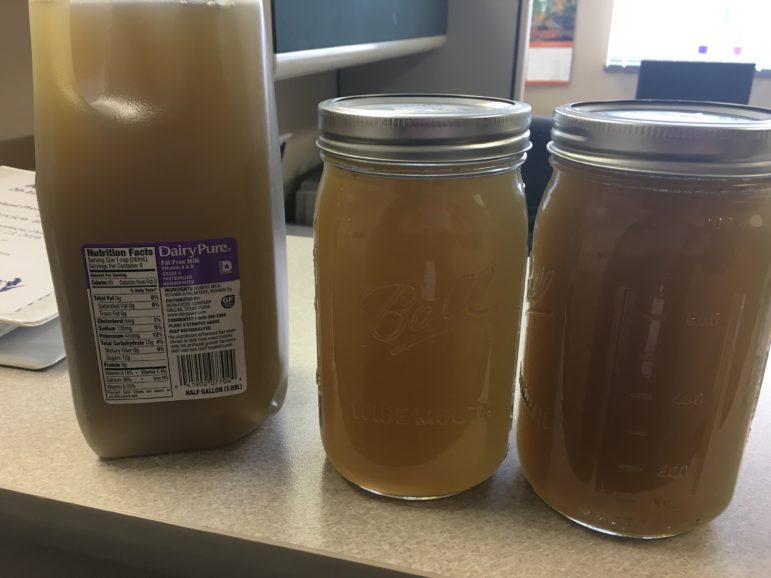
These jars contain brown water taken from a tap in Kewaunee County that researchers tied to the recent spreading of manure on a nearby field. The soil from the field and water from the home shared the same signatures for fecal contaminants. Photo courtesy of Kewaunee County Land and Water Conservation Department.
During the study, one day after a heavy rain, one home turned up with brown water that the researchers tied to manure spread on a nearby field. The soil from the field and water from the home shared the same signatures for fecal contaminants.
Five days after the rain, at one of the test homes, the same microbes turned up in clear-looking private well water about half a mile away. “Even if the water’s not brown,” Borchardt said, “it doesn’t mean you aren’t drinking contaminated water.”
Asked how to solve Kewaunee County’s water problems, Borchardt suggested an expensive fix.
“Both groups, the dairy industry, the suburban people, the exurban people, need to take care of their waste,” he said. “The solution is to centralize treatment for all pooping mammals out there.”
The nonprofit Wisconsin Center for Investigative Journalism (www.WisconsinWatch.org) collaborates with Wisconsin Public Radio, Wisconsin Public Television, other news media and the UW-Madison School of Journalism and Mass Communication. All works created, published, posted or disseminated by the Center do not necessarily reflect the views or opinions of UW-Madison or any of its affiliates.
Tainted Water
-
State’s Failures On Lead Pipes
 Jan 15th, 2017 by Cara Lombardo and Dee J. Hall
Jan 15th, 2017 by Cara Lombardo and Dee J. Hall
-
Lax Rules Expose Kids To Lead-Tainted Water
 Dec 19th, 2016 by Cara Lombardo and Dee J. Hall
Dec 19th, 2016 by Cara Lombardo and Dee J. Hall
-
DNR Program Replaces Lead Laterals
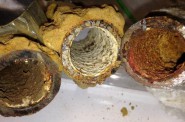 Dec 19th, 2016 by Cara Lombardo and Dee J. Hall
Dec 19th, 2016 by Cara Lombardo and Dee J. Hall


















Far more meat, beef, pork and poultry are sold by corporations globally, outside our borders, than to our own citizens. They make profits off the exploitation of our water and land and use this state and others as barnyards for the world. We can probably guess how much in taxes they are paying and who will actually foot the bill and the health consequences of this destructive free market practice as they jet off to visit their offshore accounts and build exotic homes in New Zealand or buy their own island. Growing meat for profit on the present scale is not sustainable. You can grow it for domestic use at a proper ratio of animal to land in a humane manner. Grain and vegetables are not as destructive, export those. It is not sustainable for the people in this country to grow meat for the world unless you can spin manure into gold. You can check the export vs domestic use amounts of these products for the big growth in this industry that sheds light one reason our water quality so bad. Let sanity rule. Let’s not let the GOP turn Wisconsin into a failed state.
There is simply no excuse for this. As a former dairy farmer myself there is no worse place in the state to locate these operations. Im very familiar with Kewaunee county and the Karst formations extend down into Manitowoc County where I live as well as Brown County.
It is very poor land to farm.
The ONLY reason these operations exist there is that there are few people to object and the close proximity to Highway 43 to haul in feed and export milk and cattle cheaply. CAFO owners dominate the county and town boards. The entire region has been ruined for human habitation unless you live in town with municipal water supplies.
The only long term solution is to shut them down but it will take decades if not a century to purge the aquifers of these contaminants.
Large corporate dairy farms are a recipe for disaster on several levels. Groundwater contamination due to inappropriate site selection will never deter the greed of the Republicans who control state government from allowing even more inappropriate development. The rural population of Kewaunee County uniformly votes for the right wing GOP which favors the expansion of the very corporate farming that causes their misery. The looming problem that may result in a “what the hell were we thinking” response is the very real potential for the rapid spread of antibiotic resistant disease due to thousands of animals in confined spaces. People getting sick on a regular basis is of minor concern to Governor Walker and his posse. However if corporate profits are threatened, it may be a different story.
So it seems if you add in the GOP legalized unlimited permits for high capacity wells approved to pump that pump too much water out of aquifers to the effects of CAFO’s you could have an exponential contamination effects of groundwater. More ick stuff in times less water to diffuse the nastiness = disaster? And groundwater, as I understand it as a layperson, is connected – it eventually moves around. It isn’t going to just stay in Kewaunee County.
And didn’t Scott Walker and the Republicans just pass a bill loosening controls over farm wells?
http://www.jsonline.com/story/news/politics/2017/06/01/gov-scott-walker-sign-bill-loosen-wisconsin-well-rules/361499001/